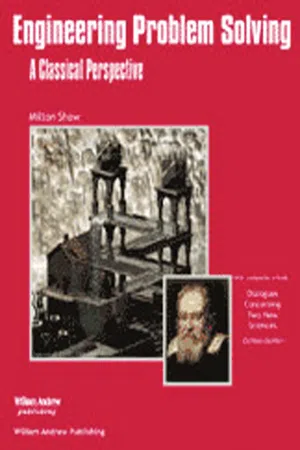
- 450 pages
- English
- PDF
- Available on iOS & Android
About This Book
Engineering, at its origins, was a profession of problem solving. The classic text, Dialogues Concerning Two New Sciences by Galileo Galilei is revisited in this ambitious and comprehensive book by Milton Shaw. In-depth discussions of passages from the Galileo text emphasize the ""mind set"" of engineering, specifically the roles played by experimentation and dialog in analysis and creativity. In the epilogue, the author points out that engineering students are usually exposed to two types of faculty. The first type is mathematically oriented and mostly interested in analytical solutions. The second type is interested in devising and experimenting with innovative solutions. However, since many talented graduates move directly into teaching instead of gaining real world experience, an imbalance of analytical teaching has occurred. Shaw points out through an example by Dr. Dave Lineback that learning to solve practical engineering problems is a very important part of an engineer's education, but is often denied due to expense and time and effort required. This book fills in many of the gaps in engineering education by showing students, and professionals, the historical background of problem solving.Among those who will find this book particularly useful are engineers working in cross-disciplinary capacities, such as mechanical engineers working with electrical engineering concepts or polymeric materials, engineers preparing for professional engineering exams, mid-career engineers looking to broaden their problem-solving skills, and students looking for help growing their skills.
Frequently asked questions
Information
Table of contents
- Front Cover
- Engineering Problem Solving: A Classical Perspective
- Copyright Page
- Contents
- Chapter 1. What Engineers Do
- Chapter 2. Rigid Body Mechanics
- Chapter 3. Dimensional Analysis
- Chapter 4. Deformable Body Mechanics
- Chapter 5. Fluid Mechanics
- Chapter 6. Aerodynamics: The Boundary Layer and Flow Separation
- Chapter 7. Similitude
- Chapter 8. Materials Science
- Chapter 9. Engineering Materials
- Chapter 10. Electrical Engineering
- Chapter 11. Thermal Engineering
- Chapter 12. Engineering Design
- Chapter 13. Engineering Economics
- Chapter 14. Engineering Statistics
- Chapter 15. Computers In Engineering
- Epilogue
- Appendix A: A Historical Introduction to Calculus
- Appendix B: Conversion Factors
- Appendix C: Abbreviations
- Answers to Problems
- Index